This is a question I get a lot from new vegans. When most people think of hummus, chickpeas come to mind. Chickpeas or garbanzo beans are, of course, plants and thus vegan.
For this reason, it may seem obvious to many that hummus is good to go. However, chickpeas are not the only ingredient, and I’d imagine most people asking this question are probably referring to lesser-known ingredients and additives.
Is it vegan? Yes, hummus is considered vegan. Like most everything, there are exceptions. After all, many varieties exist, some of which can contain additives that may be of animal origin.
What we’ll do here is cover why hummus is typically considered vegan. Then, we’ll go over non-vegan ingredients potentially present in hummus, as well as ingredients that pose problems for some vegans, but may not be considered non-vegan by community-wide standards.
Finally, we’ll go over a few products that are known to be 100% suitable for vegan consumption.
Why Hummus Is Considered Vegan
Hummus Is Primarily Made with Plant-Based Ingredients
Chickpeas/Garbanzo Beans
This is an obvious one. Chickpeas are a key ingredient in hummus and other dishes such as falafel (which uses chickpea flour) and chana masala. They’re also used in soups, stews, and salads. Tangentially, it’s a great source of plant-based protein which I’ve written an in-depth article on you can check out here.
Tahini
Tahini is a popular condiment made from roasted ground sesame seeds. It can be served by itself (usually as a dip) or incorporated into foods like hummus, halva, and baba ghanoush. It’s used in cuisines around the world such as those of the South Caucasus, Eastern Mediterranean, Middle East, North Africa, China, and Southeast Asia.
Commercially available tahini is generally free of additives so you don’t have to worry about animal-derived compounds sneaking their way in. In its production, sesame seeds are soaked in water and crushed in order to separate the bran from the kernels.
The crushed seeds are then soaked for a time in saltwater, which causes the bran to sink. The kernels remain floating on top at which point they’re skimmed off the surface, toasted, and pulverized to produce a paste.1
Plant Oils
Sunflower and/or extra virgin olive oil are common. Sunflower oil is the non-volatile (e.g. non-essential) oil obtained from pressed sunflower seeds. It has very little flavor but contributes to the oily consistency of hummus.
Olive oil is obtained by pressing whole olives. It, too, provides an oily consistency, but also adds to the flavor profile.
Unlike some controversial oils (like palm which is touched on below), plant oils commonly used in hummus are considered suitable for all vegans.
That’s not to say there are no concerns. For example, the handling of olive waste has long posed an environmental challenge due to wastewater, which totals in excess of 30 million cubic meters annually in the Mediterranean region alone. It’s also not biodegradable and can’t be processed via conventional water treatment.2
Depending on the type of vegan you are (health, ethics, ecological, etc.) this may be an issue. If you want more information, The Green Vegans wrote an article on the subject you can read here.
For the purposes of this article, I consider it vegan due to the general consensus and because it meets labeling criteria for the vegan icon.3
Lemon Juice, Salt, Garlic and Onion
These ingredients are, of course, vegan-friendly.
Other Potential Ingredients
The above are typically used in the original variety. But, hummus is a food that comes in a wide range of flavor profiles, so we’ll cover other common ingredients here.
Select Spices and Flavor Enhancers
- Cumin
- Paprika
- Chives
- Parsley flakes
- Lemon peel
- Orange peel
- Celery salt
- Chili pepper
- Chipotle pepper
- Ancho chili pepper
- Agave nectar
Select Veggies
- Diced red peppers
- Carrots and celery (garden varieties)
- Tomato paste
Nuts and Seeds
Sesame seeds and pine nuts are common ingredients. As mentioned above, tahini is actually derived from sesame seeds.
Anyway, these are all plants so no problems here.
Hummus Contains Vegan-Friendly Additives
Guar Gum
Guar gum, aka guaran, is a “galactomannan” polysaccharide—a cell wall component of the mold Aspergillus—extracted from guar beans. It’s useful as a food additive due to its stabilizing and thickening properties.
For example, its thickening prowess makes it a suitable replacement for gluten in making gluten-free products. Like gluten, it provides an elastic-like consistency and imparts structural integrity making it useful for leavening. For baking purposes, it’s produced as an off-white powder.
Then there are the stabilizing properties. It’s used to improve the stability and appearance of condiments like salad dressings, relishes, sauces, and ketchup.
Guar gum is without a doubt vegan-friendly despite sometimes being mistaken for an animal-derived additive—likely due to the fact that it’s often found in animal products (it’s used as a thickener for milk, yogurt, kefir, etc.).
I wrote a whole article on guar gum and its vegan-friendliness you can check out here.
Citric Acid
Citric acid is a weak organic acid that naturally occurs in citrus fruits. Not surprisingly, it’s also used in the Krebs aka citric acid cycle in the metabolism of aerobic organisms.
More than a million tons of the stuff is manufactured each year. Commercially, it’s used as an acidifier, in flavoring, and as a chelating agent.4
It’s one of the stronger edible organic acids, making it ideal for use in food products, typically as a preservative or flavoring agent, especially candies and soft drinks.5
Luckily, it does not require any animal-derived precursors for its production. The major production technique involves A. niger cultures that are fed on a glucose or sucrose-containing medium to produce citric acid directly. The sugar is usually sourced from molasses, corn steep liquor, or hydrolyzed corn starch.6
Like guar gum, it’s sometimes mistaken for being non-vegan as it’s often used in animal products. For example, citric acid is often added to ice cream to serve as an emulsifying agent to prevent the separation of fats.
Anyway, it’s 100% vegan-friendly.
Acetic Acid
In hummus, it’s often white vinegar. Vinegar is at least 4% acetic acid by mass and volume, the rest being water. Vinegar is used as an additive or directly as a condiment. It’s produced industrially both by bacterial fermentation and chemical synthesis, so it’s considered vegan.7-10
Potentially Non-Vegan Ingredients in Hummus
I’ve yet to see many commercial hummus varieties unsuitable for vegans, but anything can be used in homemade hummus. If you’re not the one making it, you just never know.
I have come across a few recipes that may pose problems for vegans. Again, the above ingredients pertain to commercially available hummus. However, hummus is a very popular food for game day, get-togethers, etc. and many people make their own.
You can get fancy with the flavors, plus the raw ingredients are much cheaper than buying the food pre-made. Homemade hummus can contain any number of ingredients some of which may not be considered vegan.
Palm Oil
For example, palm oil could potentially be used. In researching this article, I found three recipes that called for this ingredient.11-13
Palm oil is a controversial topic, even among vegans and not all vegans are wary of its use. I mention it here as an example because many people do like to avoid the food product.
Palm oil production has long been criticized for environmental impacts.14,15
Specific environmental concerns include:
- Deforestation and habitat loss, which threatens critically endangered species like the Sumatran tiger and orangutan.16-19
- Greenhouse gas emissions.15,20-22 The clearing of land needed for palm oil cultivation contributes directly to rising greenhouse-gas emissions.20,23 Also, palm oil plantations are often built on existing peat bogs (a wetland that accumulates peat).
Vitamin D
Another fringe additive I managed to find as an ingredient in hummus is Vitamin D.24
Vitamin D3 is typically not considered vegan as it is usually sourced from lanolin, aka wool grease—a wax secreted by the glands of wooled animals.25,26
Xanthan Gum
Some hummus contains xanthan gum as an additive.
Keep in mind that any hummus you run across containing xanthan gum isn’t considered to be non-vegan by most standards. But, many vegans do consider it to be a non-vegan ingredient.
Xanthan gum is a polysaccharide that has a number of useful properties in food production. It’s a common emulsifier and stabilizer because it’s effective in preventing the separation of ingredients. It’s also a food thickening agent like guar gum.
Xanthan gum is produced via fermentation by Xanthomonas campestris. The fermentation is usually done with simple sugars like glucose and sucrose.27
However, there are some species of the bacteria that can grow on lactose, the common simple sugar in milk.28
When grown on lactose, the bacteria are usually processed with whey protein, a waste product of the dairy industry.
Like mono- and diglycerides, some vegans find the compound to be unsuitable for consumption. But, again, products containing the substance are still considered vegan by most standards in the community.
If you’re a particularly strict vegan, then this is just something to bear in mind.
Honey
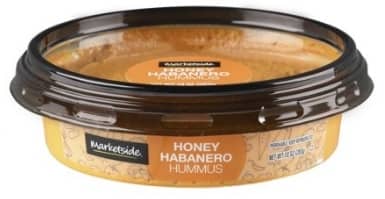
Honey is the only strictly non-vegan ingredient I’ve come across in commonly available commercial hummus.
For example, Marketside Honey Habanero Hummus contains:29
- Chickpeas (chickpeas, water, salt)
- Tahini (ground sesame)
- Canola olive/oil blend
- Water
- Red peppers (red peppers, water, salt, citric acid)
- Honey
- Sugar
- Agave syrup
- Spices (spice and coloring)
- Habanero chile puree (habanero peppers, vinegar, salt)
- Salt
- Garlic
- Potassium sorbate (to preserve freshness)
- Sodium benzoate (to preserve freshness)
Again, none of these ingredients come standard in commercially available hummus. They’re pretty rare. I generated the above list by scouring the ingredient labels for 100+ products and I didn’t find the first one to contain palm oil or vitamin D fortification of any kind.
Commercial Vegan Hummus
Now that we know hummus, in general, is considered suitable for vegans, we’ll cover a few brands and varieties that are known to be, in fact, 100% vegan-friendly.
Sabra Classic Hummus
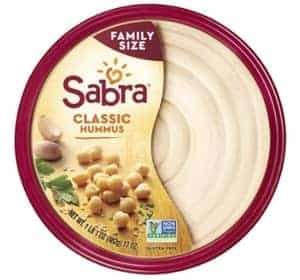
Ingredients include:30
- Cooked chickpeas
- Tahini (ground sesame)
- Non-GMO soybean oil
- Water
- Garlic
- Salt
- Non-GMO citric acid
- Potassium sorbate (for freshness)
Sabra Roasted Red Pepper Hummus
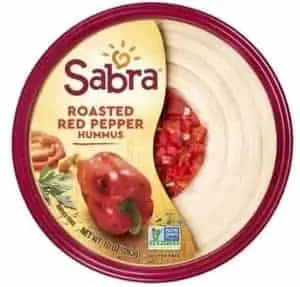
Ingredients include:31
- Cooked chickpeas
- Tahini
- Non-GMO soybean oil
- Red bell pepper
- Water
- Salt
- Non-GMO citric acid
- Potassium sorbate (for freshness)
- Natural flavors
Marketside Roasted Vegetable Hummus
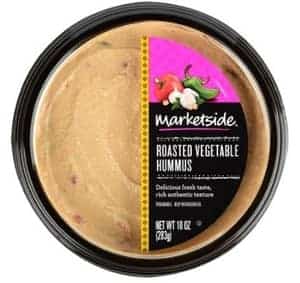
Ingredients include:32
- Chickpeas (chickpeas, water, salt)
- Water
- Canola/olive oil blend
- Tahini (ground sesame)
- Chili peppers
- Roasted red peppers (roasted red peppers, water, salt)
- Roasted garlic
- Roasted green onion
- Jalapeno peppers (jalapeno peppers, water, vinegar, salt, calcium chloride)
- Citric acid
- Salt
- Granulated garlic
- Spice
- Fried garlic concentrate (glycerin, extractives of garlic)
- Sodium benzoate (as a preservative)
- Potassium sorbate (as a preservative)
- Natural garlic flavor (canola oil, datem, extractives of garlic)
Chocolate Hummus
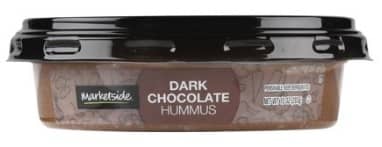
You read that right. I was a bit skeptical at first–both in terms of its flavor and vegan-friendliness. But, it is absolutely delicious and contains no animal-derived ingredients.
The ingredients include:33
- Chickpeas (chickpeas, water, salt)
- Brown sugar
- Culp
- Olive oil blend
- Water
- Cocoa powder
- Tahini
- Potassium sorbate (for freshness)
- Vanilla extract (vanilla bean extract, water, alcohol)
- Sodium benzoate (for freshness)
- Citrus fiber
- Citric acid
- Nisin preparation (an antimicrobial agent)
Anyway, that sums it up. Hummus is a vegan classic. Again, hopefully, this thorough examination of the ingredients will help you learn a few things you can use when assessing the vegan-friendliness of other food products.
References
- Helou, Anissa (2014). Davidson, Alan (ed.). The Oxford Companion to Food. Oxford University Press. pp. 802–803. ISBN 9780191040726 – via Google Books.
- Daniel Williams (September 9, 2010). “Olive pomace oil: not what you might think”. Olive Oil Times. Retrieved March 15, 2019.
- Certification https://vegan.org/certification/
- Apleblat, Alexander (2014). Citric acid. Springer. ISBN 978-3-319-11232-9.
- Frank H. Verhoff, “Citric Acid”, Ullmann’s Encyclopedia of Industrial Chemistry, Weinheim: Wiley-VCH
- Lotfy, Walid A.; Ghanem, Khaled M.; El-Helow, Ehab R. (2007). “Citric acid production by a novel Aspergillus niger isolate: II. Optimization of process parameters through statistical experimental designs”. Bioresource Technology. 98 (18): 3470–3477. doi:10.1016/j.biortech.2006.11.032
- Greenfield, Heather; Southgate, D.A.T. (2003). Food Composition Data: Production, Management and Use. Rome: FAO. p. 146. ISBN 9789251049495.
- “CPG Sec. 525.825 Vinegar, Definitions” (PDF). United States Food and Drug Administration. March 1995.
- “Departmental Consolidation of the Food and Drugs Act and the Food and Drug Regulations – Part B – Division 19” (PDF). Health Canada. August 2018. p. 591.
- “Commission Regulation (EU) 2016/263”. Official Journal of the European Union. European Commission. February 2016.
- Hemp Hummus with Red Palm Oil | Nutiva https://www.nutiva.com/kitchen/hemp-hummus-red-palm-oil
- Hummus with Red Palm Oil and Roasted Vegetables | Toni Fairman https://tonifairman.com/hummus-with-red-palm-oil-and-roasted-vegetables/
- Hummus with Red Palm Oil http://www.mpocistanbul-info.com/1/hummus-with-red-palm-oil/
- Clay, Jason (2004). World Agriculture and the Environment. p. 219. ISBN 978-1-55963-370-3.
- “Palm oil: Cooking the Climate”. Greenpeace. 8 November 2007. Archived from the original on 10 April 2010. Retrieved 30 January 2013.
- “The bird communities of oil palm and rubber plantations in Thailand” (PDF). The Royal Society for the Protection of Birds (RSPB). Archived (PDF) from the original on 6 October 2016. Retrieved 4 October 2016.
- “Palm oil threatening endangered species” (PDF). Center for Science in the Public Interest. May 2005. Archived (PDF) from the original on 17 September 2012.
- Shears, Richard (30 March 2012). “Hundreds of orangutans killed in north Indonesian forest fires deliberately started by palm oil firms”. Daily Mail. London. Archived from the original on 20 April 2013. Retrieved 1 April 2012.
- “Camera catches bulldozer destroying Sumatra tiger forest”. World Wildlife Fund. 12 October 2010. Archived from the original on 16 January 2013. Retrieved 30 January 2013.
- Foster, Joanna M. (1 May 2012). “A Grim Portrait of Palm Oil Emissions”. The New York Times. Archived from the original on 16 January 2013. Retrieved 30 January 2013.
- Yui, Sahoko; Yeh, Sonia (1 December 2013). “Land use change emissions from oil palm expansion in Pará, Brazil depend on proper policy enforcement on deforested lands”. Environmental Research Letters. 8 (4): 044031. doi:10.1088/1748-9326/8/4/044031. ISSN 1748-9326.
- “Researchers warn against high emissions from oil palm expansion in Brazil”. phys.org. 13 November 2013. Retrieved 10 April 2019.
- Rosenthal, Elisabeth (31 January 2007). “Once a Dream Fuel, Palm Oil May Be an Eco-Nightmare”. The New York Times. Archived from the original on 9 September 2017. Retrieved 30 January 2013.
- Vitad Fortified™ Hummus With Spice Powder http://www.skinauthority.com/VitaD-Fortified-Hummus-With-Spice-Powder
- Hoppe, Udo, ed. (1999). The Lanolin Book. Hamburg: Beiersdorf.
- Riemenschneider, W.; Bolt, H. M., “Esters, Organic”, Ullmann’s Encyclopedia of Industrial Chemistry, Weinheim: Wiley-VCH.
- EFSA Panel on Food Additives and Nutrient Sources (14 July 2017). “Re‐evaluation of xanthan gum (E 415) as a food additive”. EFSA Journal. European Food Safety Authority. 15 (2): e04909. doi:10.2903/j.efsa.2017.4909.
- Tortora, G.J., Funke, B.R., & Case, C.L. (2010). Microbiology: An Introduction, 10th edition. San Francisco: Benjamin Cummings. Pg. 801.
- Marketside Honey Habanero Hummus, 10 oz. https://www.walmart.com/ip/Marketside-Honey-Habanero-Hummus-10-oz/8457602
- Classic Hummus https://sabra.com/dips/hummus/classic-hummus.html
- Roasted Red Pepper Hummus https://sabra.com/ca/dips/hummus/roasted-red-pepper-hummus.html
- Marketside Roasted Vegetable Hummus, 10 oz. https://www.walmart.com/ip/Marketside-Roasted-Vegetable-Hummus-10-oz/928833164
- Marketside Dark Chocolate Hummus, 10 oz. https://www.walmart.com/ip/Marketside-Dark-Chocolate-Hummus-10-oz/925447061


